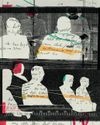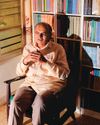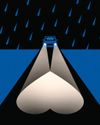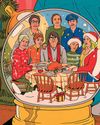
One evening in September of 1957, viewers across America could turn on their television sets and tune in to a CBS broadcast during which a young woman dropped acid. She sat next to a man in a suit: Sidney Cohen, the researcher who had given her the LSD. The woman wore lipstick and nail polish, and her eyes were shining. "I wish I could talk in Technicolor," she said. And, at another point, "I can see the molecules. I... I'm part of it. Can't you see it?" "I'm trying," Cohen replied.
Were some families maybe-oh, I don't know-eating meat loaf on TV trays as they watched this nice lady undergo her mind-bending, molecule-revealing journey through inner space? Did they switch to "Father Knows Best" or "The Perry Como Show" afterward? One of the feats that the historian Benjamin Breen pulls off in his lively and engrossing new book, "Tripping on Utopia: Margaret Mead, the Cold War, and the Troubled Birth of Psychedelic Science" (Grand Central), is to make a cultural moment like the anonymous woman's televised trip seem less incongruous, if no less fascinating.
In Breen's telling, the buttoned-down nineteen-fifties, not the freewheeling nineteen-sixties, brought together the ingredients, some of them toxic, for the first large-scale cultural experiment with consciousness-expanding substances.
The psychedelic flowering of the sixties has, it turns out, a prequel-a rich and partly forgotten chapter before the hippie movement, before the shamanistic preening and posturing of Timothy Leary, and before the war on drugs shut all that down. This earlier history encompasses not only the now notorious C.I.A. research into mind-altering drugs but also a lighter, brighter, more public dimension of better living through chemistry, buoyed by postwar scientific optimism and public reverence for expertise. "Timothy Leary and the Baby Boomers did not usher in the first psychedelic era," Breen writes.
Diese Geschichte stammt aus der January 29, 2024-Ausgabe von The New Yorker.
Starten Sie Ihre 7-tägige kostenlose Testversion von Magzter GOLD, um auf Tausende kuratierte Premium-Storys sowie über 8.000 Zeitschriften und Zeitungen zuzugreifen.
Bereits Abonnent ? Anmelden
Diese Geschichte stammt aus der January 29, 2024-Ausgabe von The New Yorker.
Starten Sie Ihre 7-tägige kostenlose Testversion von Magzter GOLD, um auf Tausende kuratierte Premium-Storys sowie über 8.000 Zeitschriften und Zeitungen zuzugreifen.
Bereits Abonnent? Anmelden

GET IT TOGETHER
In the beginning was the mob, and the mob was bad. In Gibbon’s 1776 “Decline and Fall of the Roman Empire,” the Roman mob makes regular appearances, usually at the instigation of a demagogue, loudly demanding to be placated with free food and entertainment (“bread and circuses”), and, though they don’t get to rule, they sometimes get to choose who will.

GAINING CONTROL
The frenemies who fought to bring contraception to this country.

REBELS WITH A CAUSE
In the new FX/Hulu series “Say Nothing,” life as an armed revolutionary during the Troubles has—at least at first—an air of glamour.

AGAINST THE CURRENT
\"Give Me Carmelita Tropicana!,\" at Soho Rep, and \"Gatz,\" at the Public.

METAMORPHOSIS
The director Marielle Heller explores the feral side of child rearing.

THE BIG SPIN
A district attorney's office investigates how its prosecutors picked death-penalty juries.

THIS ELECTION JUST PROVES WHAT I ALREADY BELIEVED
I hate to say I told you so, but here we are. Kamala Harris’s loss will go down in history as a catastrophe that could have easily been avoided if more people had thought whatever I happen to think.

HOLD YOUR TONGUE
Can the world's most populous country protect its languages?

A LONG WAY HOME
Ordinarily, I hate staying at someone's house, but when Hugh and I visited his friend Mary in Maine we had no other choice.

YULE RULES
“Christmas Eve in Miller’s Point.”